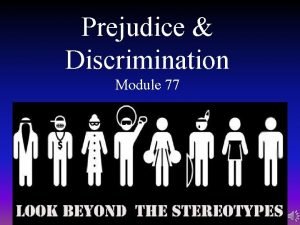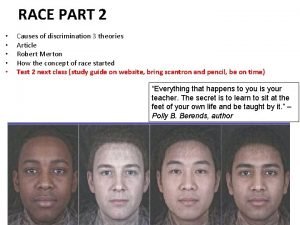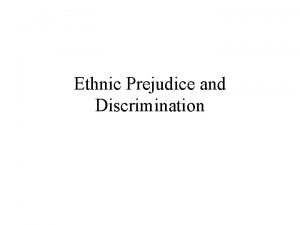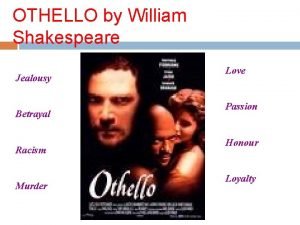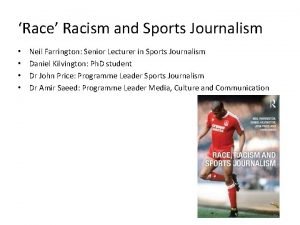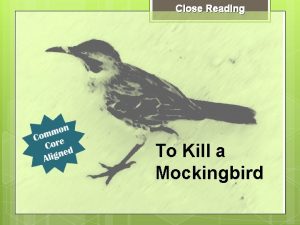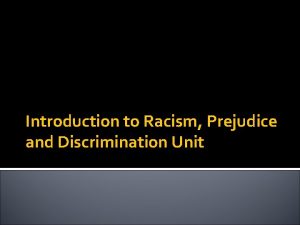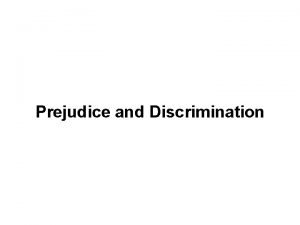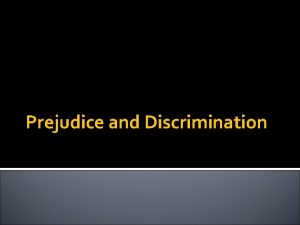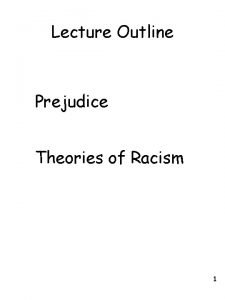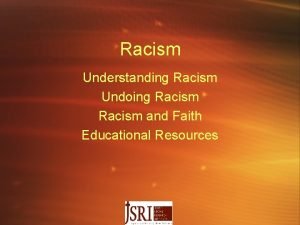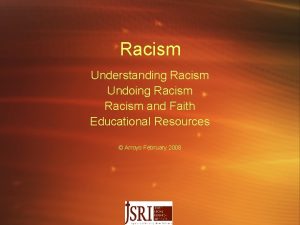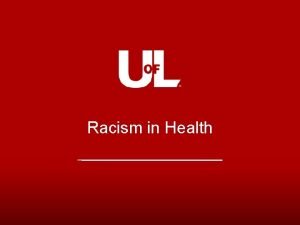Theories of Prejudice and Discrimination Prejudice Racism and










- Slides: 10

Theories of Prejudice and Discrimination • Prejudice, Racism, and discrimination – Prejudice – widely held negative attitudes toward a group (minority or majority) and its individual members • Involves a generalization based on biased or insufficient information • Based on strong emotions, therefore they are difficult to change • Ex. – Asians being good at Math – Racism – an extreme form of prejudice that assumes superiority of one group over others – Discrimination – treating people differently based on ethnicity, race, religion, or culture • Ex. – avoiding social contact, denying positions, blocking access, killing

Hate Crimes – Hate crime – a criminal act motivated by prejudice • Functionalists – members of a group are bolstering their sense of unity against a common enemy • Conflict – the victim is somehow threatening the person’s livelihood or selfinterest • Symbolic – labeling

Stereotypes – Stereotype – a distorted, exaggerated, or oversimplified image applied to a category of people • Ex – all brawn, no brain

Functionalist Perspective – By fostering prejudice, a dominant group can create a feeling of superiority over minority groups. – This can strengthen its members’ own selfconcepts. – For the majority culture, functionalists can see positive aspects of discrimination

Conflict Perspective – Majority uses prejudice and discrimination as weapons of power to control a minority. – Different minorities tend to view one another as competitors rather than as allies in their struggle against the majority

Symbolic Interactionist Perspctive – Gordon Allport’s 2 stages of learning prejudice • Pregeneralized learning period – children overhear parents make racist or prejudiced statements, but they have not yet learned to separate people by race or ethnic group • Total rejection stage – children are able to use physical clues to sort people into groups. If children repeatedly hear parents malign a minority, they will reject all members of the group – Language can reflect prejudices • In Anglo culture, many terms that include black are negative – Blackball, blacklist, black market, black eye – Self-fulfilling prophecy - an expectation that leads to behavior that causes the expectation to become reality • Ex. – kids being told they are smart or stupid continually, child being told all you will ever be is a criminal

Minority Groups in the United States • Institutionalized Discrimination – unfair practices that grow out of common behaviors and attitudes and that are a part of the structure of society – Ex – public school’s with large numbers of minority students are more likely to be located in large urban areas, not wealthier suburbs. • Hidden Unemployment – unemployment that includes people not counted in the traditional unemployment categories

African American – Largest racial minority group in America – Barriers to African American assimilation • Skin color and physical features • Limited upward social mobility for many generations • Barely 50 years of constitutional equality – Average income levels • About 64% of that of whites • The average African American family holds less than ¼ of the wealth of the average white family – Job market • Almost twice as likely as whites to work in low-level service jobs • Jobless rates are double those of whites • About 1/3 teenagers are unsuccessfully looking for work – Advances • Professional and technical occupations have increased 128% since 1960 s • 2 times the managers or officials since 1960 • Increase in government representation

Latinos – One of the fastest growing minorities in the U. S. – Largest minority group in U. S. – Over 60% of Latinos in America are of Mexican decent – Each group came to the U. S. under different circumstances – Education • Over 50% have completed high school – Average income is greater than African Americans, but lower than non-Latino whites

• Native Americans – Just over 2, 000 in total population – Fewer Native Americans graduate from high school than any other major minority group – Lowest annual income of any minority group – About ¼ live on reservations – Gaming facilities are helping improve life • Asian Americans – About 4 % of total U. S. population – Face severe persecution early on – Have became successful by using the education system for upward mobility
 Module 77 prejudice and discrimination
Module 77 prejudice and discrimination Allport's scale diagram
Allport's scale diagram Merton's typology of prejudice and discrimination
Merton's typology of prejudice and discrimination Prejudice
Prejudice Robert vischer empathy theory disadvantages
Robert vischer empathy theory disadvantages Theories of prejudice sociology
Theories of prejudice sociology Shakespeares tragedy about racism and jealousy
Shakespeares tragedy about racism and jealousy Shakespeare's tragedy about racism and jealousy
Shakespeare's tragedy about racism and jealousy What is coloniazation
What is coloniazation Race racism and sports journalism
Race racism and sports journalism Page 172 to kill a mockingbird
Page 172 to kill a mockingbird
